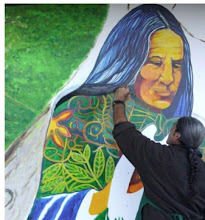
Color Theory # 7- Atmospheric perspective
Create a landscape painting, showing atmospheric perspective.
Bristol or illustration board. Please mount Bristol paper and create a hinged cover sheet.
8x10 on 9x12 surface.
media: Acrylic and /or gouache
For this assignment it is best to look at some landscape photos or paintings, although it is fine to make up a fantasy landscape if you are so inclined.
You can work from a photograph that shows atmospheric perspective. You can also put together different photo images in order to improve foreground/s, middle areas and back grounds…
Don't worry so much about exactly reproducing the image, instead use it as a reference for a landscape which shows the interplay of light and color as things recede into the distance.
Atmospheric perspective is sometimes called aerial perspective.
ATMOSPHERIC PERSPECTIVE
Atmospheric perspective deals with how the appearance of an object is affected by looking at it through a layer of air. Moisture, dust and pollutants in the atmosphere act to filter the visual information.
This is most apparent on a foggy day when it may be difficult to see across the street. Even in the clear, dry air of a desert the atmosphere changes the appearance of distant objects.
The changes follow the following general rules:
Contrast is greatest for close objects. Distant objects have less contrast in them and less to their surroundings. Each row of hills receding into the distance has less contract with the next (see photo above).
Remember that value contrast is the strongest contrast when creating spatial illusions.
Colors also change with depth. All of the colors are clear on near objects. Bright colors are only seen on close objects. Warm colors also show up more on near objects. As objects get farther away the colors dull and eventually turn blue gray.
Partially because of this warm colors appear to closer than cool colors (more about this under color). Choose colors in an image accordingly.
Focus in an image also gives depth clues. Close objects are generally more sharply focused than distant objects. It is possible to alter this with a camera but the mind sees soft focused edges as being farther away than sharp edges. There may be compositional reasons to soften the focus of close objects in an image to call attention on something farther back in space.
Details are much more apparent on near objects because of all of the above. Linear perspective makes more distant details too small to see but it is low contrast that tends to flatten distant objects.
Pay attention to how these concepts play out when you are looking at landscape. The same tree looks not only smaller in the distance (linear perspective) but also less leafy (contrast, detail and focus) and not as bright a green (color). As the trees get farther away they blend into the landscape and eventually all you see are rows of hills, flat as cutouts, receding to the horizon. This is especially true on a hazy day or when looking into the sun.
ATMOSPHERIC PERSPECTIVE CONSIDERATIONS
Contrast: Use a highly contrasting image for the foreground. It should have high contrast within it and contrast with its surroundings in your image. As the scene goes farther back, use less and less contrast. Be aware of a highly contrasting background with a softer middle ground.
Color: Keep the foreground bright and warm in color. The background should be the dullest and coolest in color. Be careful of warm colors in the background since they will want to come forward.
Focus: Make the foreground the sharpest in the image, the middle ground the next sharpest and the background the dullest if possible.
Details: Use an object for the foreground that has a lot of details. The background should be chosen because it has little in the way of details. The middle ground, as usual, is in the middle
